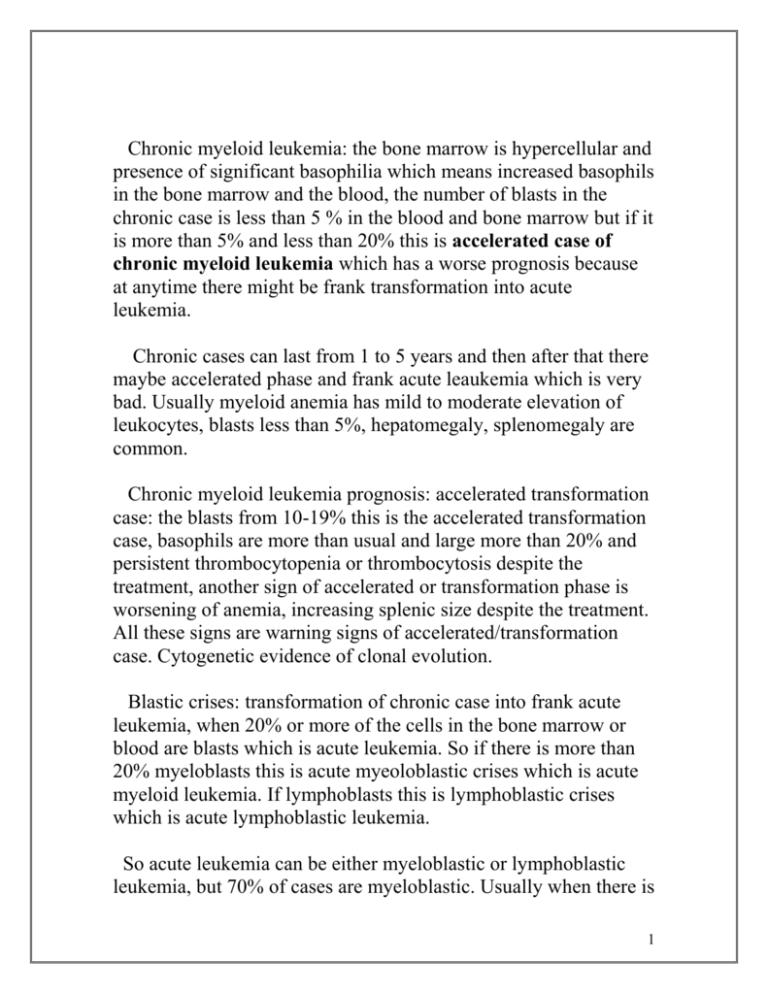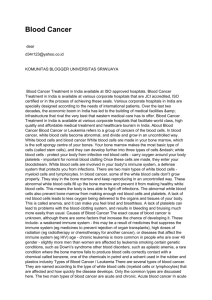Chronic myeloid leukemia: the bone marrow is hypercellular and
advertisement

Chronic myeloid leukemia: the bone marrow is hypercellular and presence of significant basophilia which means increased basophils in the bone marrow and the blood, the number of blasts in the chronic case is less than 5 % in the blood and bone marrow but if it is more than 5% and less than 20% this is accelerated case of chronic myeloid leukemia which has a worse prognosis because at anytime there might be frank transformation into acute leukemia. Chronic cases can last from 1 to 5 years and then after that there maybe accelerated phase and frank acute leaukemia which is very bad. Usually myeloid anemia has mild to moderate elevation of leukocytes, blasts less than 5%, hepatomegaly, splenomegaly are common. Chronic myeloid leukemia prognosis: accelerated transformation case: the blasts from 10-19% this is the accelerated transformation case, basophils are more than usual and large more than 20% and persistent thrombocytopenia or thrombocytosis despite the treatment, another sign of accelerated or transformation phase is worsening of anemia, increasing splenic size despite the treatment. All these signs are warning signs of accelerated/transformation case. Cytogenetic evidence of clonal evolution. Blastic crises: transformation of chronic case into frank acute leukemia, when 20% or more of the cells in the bone marrow or blood are blasts which is acute leukemia. So if there is more than 20% myeloblasts this is acute myeoloblastic crises which is acute myeloid leukemia. If lymphoblasts this is lymphoblastic crises which is acute lymphoblastic leukemia. So acute leukemia can be either myeloblastic or lymphoblastic leukemia, but 70% of cases are myeloblastic. Usually when there is 1 frank blast crises there will be additional cytogenetic abnormalities. We mentioned last lecture that there is Philadelphia chromosome in the chronic case, but if there is additional Philadelphia chromosome it is a bad sign or additional new cytogenetic abnormalities. Chronic myeloid leukemia is a good example of a malignant disease and its treated by targeted therapy glibec (hematenip) *the spelling is wrong I think* inhibits the tyrosine kinase activity of BCRABM (know this), also there is hydroxy uria and alphainterferon. In young patients bone marrow transplantation is the treatment especially during chronic phase. After the age 60-65 B.M transplantation is difficult. SO chronic myeloid leukemia in the elderly the prognosis is very bad, so the younger the patient the more response from B.M transplantation BUT it should be done in the chronic phase BEFORE development of blastic crises BEFORE development of transformation (accelerated) phase. In other words in the 1st few years of the disease. Chronic myeloid leukemia is the 1st malignancy associated with chromosomal transformation and therapeutic agents have been used (glibec). The 2nd disorder in the chronic myeloid proliferative disease is polycythemia vera it is a serious clonal disorder of urypotent hematopoietic stem cells. So stem cells are the major target in this chronic myeloid disorder. It is characterized by expansion of the red cell mass but the other marrow elements can also be affected but the major predominant change is the RBC mass, many many RBCs are produced so the Hemoglobin will increase. There are certain criteria for polycythemia vera, all 3 hematopoietic cell lines are affected coz the problem is in the stem cells. The characteristic findings are: Expanded red cell mass, splenomegaly, bone marrow hyperplasia, and leukocytosis. The majority of marrow cells are affected. Diagnostic criteria: Category A (major and more 2 important) and category B and a combination of A and B. For example: red cell mass in male is more than 36. Calculate total RBC mass and the total weight and divide them. In female more than 32. Arterial oxygen should be normal, suppose we have hypoxia there will be 2ndry polycythemia not called polycythemia vera which is a primary disorder with no obvious cause. So oxygen should be normal; saturation more than 92%. Splenomegaly and clonal genetic abnormalities EXCLUDING Philadelphia chromosome, Endogenous erythroid colony formation in vitro. In category B: thrombocytosis more than 400,000 leukocytosis more than 12,000 B.M with anylosis, low serum erythropoietin level. A1+A2+any other category A is enough for the diagnosis or any two from category A is enough. Clinical findings are usually related to expanded RBCs. Increased blood viscosity and a possibility of thrombosis, headache, heaviness, weakness, hypertension, pruritus(itch) especially after a hot bath, facial rubor, vascular occlusive episode which is very important and splenomegaly. Laboratory findings: RBC count, leukocyte count, platelet count. Normal or elevated leukocyte alkaline phosphatase score. Remember that’s this is decreased in chronic myeloid leukemia. B.M hyperplasia, low iron, expanded red cell mass (more than 36%in male and more than 32% in female), positive endogenous erythroid colony in assay. Stem cells will form these colonies without added erythropoietin, elevated uric acid and vitamin B12 and low erythropoietin levels. The function of erythropoietin is stimulating the bone marrow to produce more RBCs. There are some diseases that produce more erythropoietin in that case there is 2ndry polycythemia not polycythemia vera. Ex. Renal cell carcinoma and angioblastoma in the cerebellum can produce a lot of erythropoietin which will cause 2ndry polycythemia. 3 Causes of polycythemia: polycythemia vera: no cause, or 2ndry polycythemia: smoking, heart disease, abnormal hemoglobin, hypoxia, arterial-venous malformation, renal lesions, hepatocellular carcinoma, renal cell carcinoma, adrenal tumor…..etc. so there are many tumors that can secrete erythropoietin and cause 2ndry polycythemia. Treatment: hydroxy uria, radio active phosphorus (harmful that can induce 2nd malignant process so only used in the elderly), phlebotomy (drainage of venous blood), leeches. In the late stage of polycythemia vera there maybe fibrosis, red cell mass normalizes then decreases, leuko-lymphoblastic picture, splenomegaly. Polycythemia vera if left untreated the average survivor is 18 months (1.5-3 years), but with treatment the average is 10 years. Complications like thrombosis can be serious. Hemorrhage, peptic ulcer, mild fibrosis, acute leukemia (transformation and overlapping of 1 disorder into another), essential thrombocythemia which is the opposite of thrombocytopenia. Significant increase in the platelet count. Essential means no obvious cause. Colonal stem cell disorder (all stem cells). Normal platelet count is 150,000450,000 but here it can be more than 1,000,000. Hyperplasia of megakaryocytes in the B.M, and many platelets in the blood. Absence of chromosomal abnormalities, expanded red cell mass, myelofibrosis, abscess of known causes of thrombocytosis. We mentioned that Iron Deficiency Anemia can cause thrombocytosis, if obvious cause we say reactive not essential thrombocythemia. In the blood film we can see a huge number of platelets and giant platelets. Thrombocytosis has causes: essential, myeloproliferative disorders, hemorrhage, iron deficiency anemia, hemolysis, inflammation, and malignancy after removal of the spleen….etc. 4 Clinical manifestations of essential thrombocythemia maybe asymptomatic, splenomegaly, hemorrhage, thrombotic attacks (bleeding tendency or thrombosis), venous or arterial thrombosis, recurrent GIT bleeding, nasal bleeding, pain in the calf and toes, iron deficiency due to bleeding and acute leukemia (10% of essential thrombocythemia patients will develop acute leukemia). If we perform a B.M study we see huge numbers of large megakaryocytes that can be abnormal in morphology and sheets of them. These megakaryocytes are active and can produce huge numbers of platelets so the count can be more than 1 million. In laboratory diagnosis: platelet count (more than 600,000), so if the platelets are more than 600,000 and with no obvious cause its essential thrombocythemia and usually more than 1 million, mild anemia, leukocytosis (less than 40,000), normal leukocyte alkaline phosphatase, hypercellular marrow and megakaryocytic hyperplasia. Lastly about chronic myeloid proliferative disorder is idiopathic (primary, essential) this all means no obvious cause. Idiopathic myeloid fibrosis is an example of chronic myeloid proliferative disorder characterized by fibrosis of bone marrow, splenomegaly like chronic myeloid leukemia (spleen weight more than 1000 gm), extra-medullary hematopoiesis because there is no hematopoiesis in the B.M coz of fibrosis, difficulty to produce adequate hematopoietic cells so extra-medullary hematopoiesis compensates for this so there will be hepatomegaly, splenomegaly, lymphadenopathy. Leukoeryrthroblastic reaction and tear drop RBC's which is very characteristic of myelofibrosis. Leukoeryrthroblastic reaction means nucleated RBC's in the blood and relatively immature stages of myeloid cells (myelocyte, promyelocyte, band form, metamyelocyte and nucleated RBC's) this is not specific but it is characteristic and common in 5 myelofibrosis. The bone marrow in these patients is a dry tap which means its difficult to aspirate the marrow coz of fibrosis. So we can say on of the causes of dry tap is idiopathic myelofibrosis but there are other causes. So we can't aspirate in dry tap so we… BIOPSY. Trephine biopsy where we take a piece of the bone where we will se evidence of fibrosis. It's usually asymptomatic in the early phase (the 1st 2 years). Splenomegaly due to the vascular expansion and myeloid metaplasia, anemia with progressive worsening, elevated neutrophil count with high leukocyte alkaline phosphatase score, leukoerythroblastic reaction then dry tap in the B.M. We see teardrop RBC's and nucleated RBC's. We do reticuline stain on the biopsy and we see a lot of reticuline fibers that aren't seen normally. Also increase in collagen fibers. Differential diagnosis means what are the other diseases that can be confused with myelofibrosis: cirrhosis, fibrotic marrow, leukoerythroblastosis due to many things like leukemia and lymphoma, myelodysplastic syndrome and osteopetrosis. Myelodysplastic syndrome: clonal disorder of hematopoietic stem cells, there is ineffective hematopoiesis and the bone marrow is hyper cellular and there is evidence of ancytopenia in the blood, peripheral ancytopenia, a tendency to develop acute myeloid leukemia and morphological abnormalities of peripheral blood and bone marrow cells. The morphology of the bone marrow of myelodyplastic syndrome: ring sidroblast, megaloblastic erythroid precursor, hypogranular myeloid cells, hyposegmentation, hypersegmentation and abnormal megakaryocytes, fragmentation of the nuclei which is a sign of diserythropoiesis. With iron stain we see abnormal 6 arrangement of iron particles around the nuclei which is called ringed sidroblasts. Refractory anemias with ringed sidroblast have dysplasia confined to the erythroid cells but anything else isn't only in the RBC's coz it’s a stem cell disorder. Management/ supportive treatment: growth factor, chemotherapy but most importantly bone marrow transplantation which is effective in selected cases of acute leukemia, many cases of chronic myeloid leukemia and some cases of myelodysplastic syndrome but usually in young patients. Myelodysplastic syndrome prognosis: aggressive when there excess of blast, refractory anemia with excess or when there chronic myelo-monocytic leukemia and the average survivor time is 6 months to 1 year but in other types it can be 6-10 years and they usually die of cytopenic complications (hemorrhage, infection…) not transformation 7




